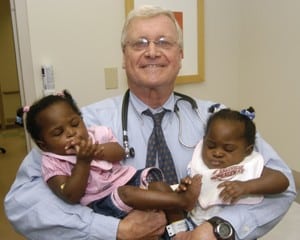UAMS Pediatrician Pens JAMA Editorial on Child Hunger
Aug. 3, 2010| UAMS’ Patrick H. Casey, M.D., is the lead author of an editorial published in the August issue of the Archives of Pediatrics & Adolescent Medicine, calling for national policies that address child hunger issues. The Archives of Pediatrics & Adolescent Medicine is a Journal of American Medical Association/Archives journal. The editorial, which had three other authors, accompanies an in-depth report on child hunger and food insecurity. Casey, a pioneer in the early diagnosis and treatment of developmental problems in children, is the Harvey and Bernice Jones Professor of Developmental Pediatrics at the University of Arkansas for Medical Sciences (UAMS) College of Medicine. Food insecurity – a lack of adequate access to food for financial reasons – affected about 15 percent of American households in 2008, an increase from 11 percent in 2007 and the highest prevalence since monitoring began in 1995, the journal report states. Child hunger is an extreme manifestation of food insecurity, defined as a period of time when children experience being hungry because their family has run out of food or the money to buy food. Children who experience hunger appear more likely to have health problems, and repeated episodes of hunger may be particularly toxic, according to the journal report. The editorial notes that the prevalence of food insecurity among all households with children was 21 percent in 2008 and 37 percent of female-headed households with children were food insecure. While data are not yet available for 2009, an increase in joblessness and cuts in family support programs may have increased food insecurity even further, the editorial states. “This unacceptably high prevalence of food insecurity in households with children in the United States underscores the need to implement preventive and therapeutic policy measures that would have a positive effect on both health and economic dimensions,” writes Casey, who is based at Arkansas Children’s Hospital. “Policy solutions to such problems are entirely feasible, simply by strengthening and expanding systems already in place.” The editorial comes as the Child Nutrition Program Act, reauthorized every five years, is being debated in Congress. The act encompasses food-related programs targeting children, including school meals, the Supplemental Nutrition Assistance Program (SNAP, formerly the food stamp program), the Special Supplemental Nutrition Program for Women, Infants and Children, and the Child and Adult Care Food Program. “The reauthorization of these programs creates an opportunity for pediatric health professionals to educate policy makers that nutritious foods, which cost more than low-nutrient, energy dense alternatives, are potent medicine for improving our children’s health and developmental potential and decreasing costly hospitalizations and special-education needs,” the editorial states. Potential policy changes include increasing reimbursements to cover healthier foods, expanding programs to allow more children to participate and adding a third-meal option for preschool programs in which children are in care for long hours each day. Casey established the College of Medicine’s first developmental center in 1979 (now the James L. Dennis Developmental Center), which introduced a team concept to diagnosing children with developmental conditions. In 1984, Casey began participating in national research on the effects of intensive early intervention for children born prematurely and with a low birth weight. The benefits were so dramatic, they led Casey to establish 11 KIDS FIRST centers across Arkansas. KIDS FIRST has drawn national attention and acclaim for its unique approach to serving children at risk for developmental disabilities. In 1990, Casey founded the Center for Applied Research and Evaluation (CARE) in the Department of Pediatrics and served as CARE’s director until 2006. In 2006, he initiated a program called the Medical Home Clinic for Special Needs Children. He is an active clinician and directs the Growth and Development Program, a multidisciplinary referral clinic for children with failure-to-thrive and developmental problems in infancy/toddler years. |
